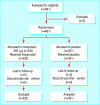Effect of sublingual misoprostol on severe postpartum haemorrhage in a primary health centre in Guinea-Bissau: randomised double blind clinical trial
- PMID: 16195287
- PMCID: PMC1239973
- DOI: 10.1136/bmj.331.7519.723
Effect of sublingual misoprostol on severe postpartum haemorrhage in a primary health centre in Guinea-Bissau: randomised double blind clinical trial
Abstract
Objective: To evaluate whether routine administration of sublingual misoprostol 600 microg after delivery reduces postpartum haemorrhage.
Design: Randomised double blind placebo controlled trial.
Setting: Primary health centre in Bissau, Guinea-Bissau, West Africa.
Participants: 661 women undergoing vaginal delivery.
Intervention: Misoprostol 600 mug or placebo administered sublingually immediately after delivery.
Main outcome measures: Postpartum haemorrhage, defined as a loss of > or = 500 ml and decrease in haemoglobin concentration after delivery.
Results: The incidence of postpartum haemorrhage was not significantly different between the two groups, the relative risk being 0.89 (95% confidence interval 0.76 to 1.04) in the misoprostol group compared with the placebo group. Mean blood loss was 10.5% (-0.5% to 20.4%) lower in the misoprostol group than in the control group. Severe postpartum haemorrhage of > or = 1000 ml or > or = 1500 ml occurred in 17% (56) and 8% (25) in the placebo group and 11% (37) and 2% (7) in the misoprostol group. Significantly fewer women in the misoprostol group experienced a loss of > or = 1000 ml (0.66, 0.45 to 0.98) or > or = 1500 ml (0.28, 0.12 to 0.64). The decrease in haemoglobin concentration tended to be less in the misoprostol group, the mean difference between the two groups being 0.16 mmol/l (-0.01 mmol/l to 0.32 mmol/l).
Conclusion: Sublingual misoprostol reduces the frequency of severe postpartum haemorrhage.
Figures
References
-
- Rush D. Nutrition and maternal mortality in the developing world. Am J Clin Nutr 2000;72: 212S-40S. - PubMed
-
- Brabin BJ, Hakimi M, Pelletier D. An analysis of anemia and pregnancy-related maternal mortality. J Nutr 2001;131: 604-615S. - PubMed
-
- Kaestel P. Micronutrient supplementation and other predictors of birth size and perinatal mortality in Guinea-Bissau [thesis]. Copenhagen, Denmark: Department of Epidemiology Research, Statens Serum Institute, 2004.
-
- Hoj L, Stensballe J, Aaby P. Maternal mortality in Guinea-Bissau: the use of verbal autopsy in a multi-ethnic population. Int J Epidemiol 1999;28: 70-6. - PubMed
-
- Kwast BE. Postpartum haemorrhage: its contribution to maternal mortality. Midwifery 1991;7: 64-70. - PubMed
Publication types
MeSH terms
Substances
LinkOut - more resources
Full Text Sources



